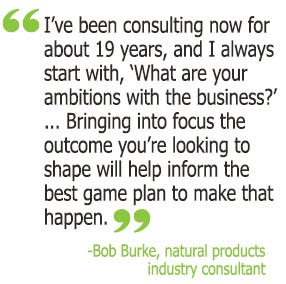
 It’s been nearly a decade and a half since natural products industry veterans Bob Burke and Rick McKelvey published the first edition of their Natural Products Field Manual to guide entrepreneurs and natural products companies of all sizes and stages to grow their businesses more profitably—and a lot has changed since then.
It’s been nearly a decade and a half since natural products industry veterans Bob Burke and Rick McKelvey published the first edition of their Natural Products Field Manual to guide entrepreneurs and natural products companies of all sizes and stages to grow their businesses more profitably—and a lot has changed since then.
“It’s been really gratifying to see that a lot of reasons why a lot of folks got into the industry—in terms of personal beliefs about where food comes from and that the things we put in and on our bodies can contribute to long-term wellness—are largely proving to be true,” Burke says. “The rest of the world has moved in this direction, and all of the underlying drivers of growth over the last 15 to 20 years have proven to be long-term trends versus passing fads.”
With the release of the seventh edition of the manual this spring, we talked with Burke about what’s new and what he’s learned from two decades of consulting with natural product companies.
So tell us what’s new in this new edition?
Bob Burke: A major part of the update is all of the trade customer information—the profiles of key distributors and retailers in the different channels—how to succeed with them, what kind of programs do they prefer, what are they looking for from suppliers and what distributors they use.
We’ve also added new content related to ecommerce as well as an updated section on Canada and sections around supply chain and working with co-manufacturers. This material is among four volumes, 44 chapters of content and insights from 60 outside contributors.
Let's dive into that ecommerce piece. When a company is thinking about selling online, what are some of the considerations as to whether ecommerce is a good place to start?
BB: Clearly it’s thinking about how your products lend themselves to it. There are the practical considerations such as what is your pack size, weight, how fragile and shelf life? Also, what is your pricing and channel strategy? How do you do this profitably? How do you balance the needs of the ecomm channel with your existing brick-and-mortar retailers?
For small brands, where do you think the opportunity is with those brick-and-mortar retailers? Smaller natural-focused retailers, or big guys like Target, etc.?
BB: For most small brands, the natural-focused retailers tend to be less expensive and more forgiving to enter and a better match with the consumer. The first order of business for most new brands is to crack the code of what does it take to sell off-the-shelf—what is the optimal price point, where to merchandise, understanding the right product mix and how to tell your story to the trade and consumer.
Having said that, the channels are shifting rapidly. So much has to do with a brand’s bandwidth. What resources do they have to manage it effectively? Having a channel strategy is important so that you think about what your offerings and pricing are in your core natural channel, versus what you might be putting out in more mainstream conventional retailers. One factor is how much education is required for your product? Some nutritional categories, such as supplements and personal care, require a lot more in the way of education and product training than a branded food product on the shelf.
At the end of the manual, there’s a section titled, “If we knew then what we know now.” Can you share some of your big lessons?
BB: A theme of the whole book is doing your homework. So many entrepreneurs and even larger companies get rambunctious—they just want to get out there, figure it out as they go—and sadly often have their heads handed to them. So the No. 1 thing is put together a solid game plan—understand the expectations of the trade, the right route to market, the partners to work with, resources required, costs that will be incurred and common pitfalls to avoid.
often have their heads handed to them. So the No. 1 thing is put together a solid game plan—understand the expectations of the trade, the right route to market, the partners to work with, resources required, costs that will be incurred and common pitfalls to avoid.
Another one is that even though we’re all very data-driven and analytical by nature, we also have to think in terms of emotional intelligence, relationships and building a great culture. A lot of people in the natural channel do have shared values, so relating to people and being mindful of personal relationships probably goes a little further in this industry than in other businesses. For example, when you’re working with a broker, getting an unfair share of their time in part because you take the time to get to know them, get to know their business, have them understand what you’re looking to accomplish, and you’re not just doing a market visit and pointing out everything that’s wrong.
I’ve been consulting now for about 19 years, and I always start with, “What are your ambitions with the business?” Are you looking to grow it and sell it in three to five years, or to do this long term? Some of the companies I’ve worked with have been multigenerational family businesses, and they obviously have a different agenda than someone who’s funded and looking to exit at an irrational valuation. Bringing into focus the outcome you’re looking to shape will help inform the best game plan to make that happen. Hopefully we’ve been able to compile a lot of expertise, experience and insights to help accomplish your goals while sidestepping the most common pitfalls and short cutting the learning curve. Learn more about the Natural Products Field Manual here.
About the Author(s)
You May Also Like




